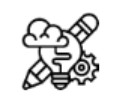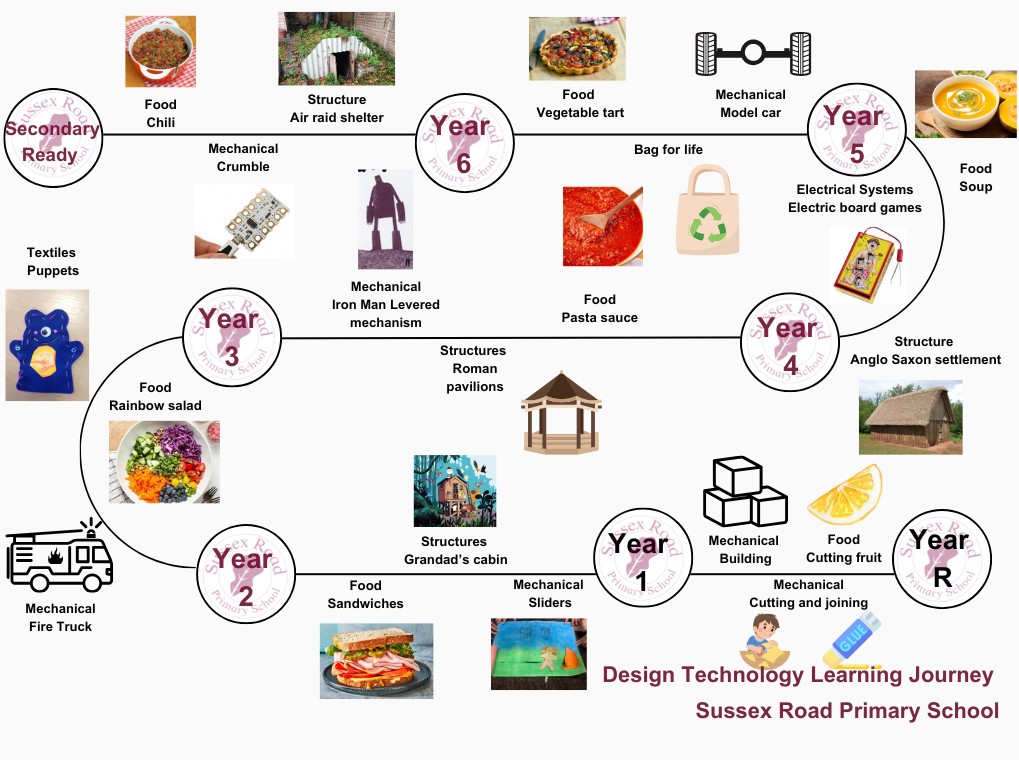Design Technology
 At Sussex Road, we aim to inspire pupils to be innovative and creative thinkers who have an appreciation for the product design cycle through ideation, creation, and evaluation. We enable pupils to develop the confidence to take risks, through drafting design concepts, modelling, and testing and to be reflective learners who evaluate their work and the work of others.
At Sussex Road, we aim to inspire pupils to be innovative and creative thinkers who have an appreciation for the product design cycle through ideation, creation, and evaluation. We enable pupils to develop the confidence to take risks, through drafting design concepts, modelling, and testing and to be reflective learners who evaluate their work and the work of others.
Through our bespoke curriculum, we aim to build an awareness of the impact of design and technology on our lives and encourage pupils to become resourceful, enterprising citizens who will have the skills to contribute to future design advancements. We enable children to develop creative, technical and practical expertise to complete everyday tasks confidently and participate successfully in an increasingly technological world. We equip our children with the skills to understand and apply the principles of nutrition and learn how to plan and make healthy meals.

We have written a bespoke curriculum pertinent to Sussex Road. We have used the National Curriculum and DT association to build our progression model across the school. This ensures that skills and knowledge are built on year by year and sequenced appropriately to maximise learning for all children.
All teaching of DT will follow the design, make and evaluate cycle. Each stage of the design process is underpinned by technical knowledge. The design process will be rooted in real life and relevant contexts to give meaning to learning. While making, children will be given choice and a range of tools to choose freely from. To evaluate, children will be able to assess their own products against a design criteria. Each of these steps will be rooted in technical knowledge and vocabulary.
When designing and making, the children are taught to:
Design:
- Work confidently within a range of contexts: home, school, leisure, culture, enterprise, industry.
- Carry out research, using surveys, interviews, questionnaires and web based resources.
- Identify the needs wants, preferences and values of particular individuals and groups.
- Develop a simple design specification to guide their thinking.
- Model their ideas through cross-sectional drawings and exploded diagrams, pattern pieces and CAD.
- Generate innovative ideas, drawing on research.
Make:
- Explain their choice of tools and equipment in relation to the skills and techniques they will be using.
- Explain their choice of materials and components according to the functional properties and aesthetic qualities.
- Formulate step-by-step plans as a guide to making.
- Follow procedures for safety and hygiene.
- Accurately measure, mark out, cut and shape materials and components.
- Accurately assemble, join and combine materials and components.
- Accurately apply a range of finishing techniques, including those from art and design.
- Demonstrate resourcefulness when tackling practical problems.
Evaluate:
- Consider the views of others, including intended users, to improve their work.
- Critically evaluate the quality of the design, manufacture and fitness for purpose of their products as they design and make.
- Evaluate their final products against their original design specification.
Technical knowledge:
- Apply their understanding of how to strengthen, stiffen and reinforce more complex structures.
- Understand and use mechanical systems in their products.
- Understand and use electrical systems in their products.
- Apply their understanding of computing to program, monitor and control their products
- Understand some of the ways that food can be processed and the effect of different cooking practices (including baking and grilling).
Children will have clear enjoyment and confidence in design and technology that they will then apply to other areas of the curriculum. Children will ultimately know more, remember more and understand more about Design Technology, demonstrating this progression of skills, knowledge and understanding when using tools or skills in other areas of the curriculum and in opportunities out of school.
Children have a clear understanding about the purpose of their learning and how they can use and implement the skills taught in the wider world. Children will build their problem solving capabilities and resilience, understanding that failure is inevitable and that DT is the process, not the outcome. As designers, children will develop skills and attributes they can use beyond school and into KS3.
What you would see in a Design Technology lesson at Sussex Road Primary School?
- Children who can confidently reflect on their learning, evaluating their products against a design criteria.
- Food technology taught in each year group.
- Children cooking in a food highly equipped food technology kitchen.
- Children using their problem solving skills and resilience to overcome challenges, understanding that making mistakes is ok.
- Children who can use their resourcefulness when tackling practical problems.
- Children who follow procedures for safety and hygiene.
- Children who can evaluate their final products against their original design specification.
